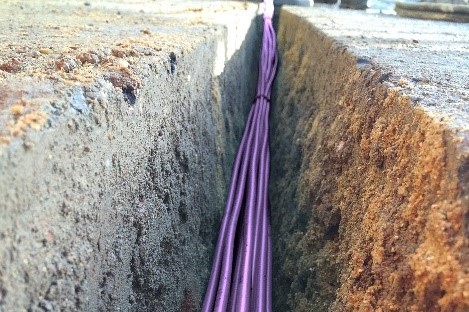Scott Modha takes a look at how the right technique goes a long way, and network operators could benefit from simplified microduct network deployments
As emerging technologies such as the Internet of Things (IoT), 5G and Virtual and Augmented Reality increase at an exponential rate, the need to lay fibre to the doors of residential premises and businesses at the same speed has never been greater.
As a ‘call to action’ in response to these demands, governments across the globe are introducing broadband plans to ensure superfast broadband can be delivered straight to the homes and offices of end-users.
However, it is the network operators who are feeling the heat the most – as the pressure builds to place more fibre into their networks. In light of this, they are looking for easier and faster ways to reach subscribers with full fibre. This must be balanced with ensuring installation and labour costs are kept to a minimum and their existing deployments and assets can be protected from damage.
Building blocks
For operators, the proliferation of new and emerging technologies not only presents opportunities, but challenges too. On the one hand, by embracing these technologies, they can expand their customer offerings to new services and applications, which, in turn will generate additional revenue. On the other hand, they can’t monetise these technologies if their networks can’t support or enable them.
If operators are to ensure their networks can keep up to speed with emerging trends, they must lay the foundations of a modern network. When it comes to optical fibre networks, each fundamental building block must be carefully considered: the optical fibre cables; the connectivity to join and route them; the active equipment to ‘light’ the fibres and a duct or microduct system to contain and facilitate installation; repair and removal/replacement of the cables.
However, fibre optic cables often come with a hefty price tag, so it is essential that they are protected during installation. This, and the combination of the need to install them by air-blowing, has given rise to the popularity of microducts.
A single microduct is a flexible pipe with an external diameter between 3 and 16mm, designed to accommodate a single optical fibre cable or unit. This enables a fibre product to be installed by pulling, pushing, or more normally by air-blowing. Thanks to these abilities, microducts are emerging as a solution which can provide operators with a pathway to quick, easy, clean and cost-effective installations, via blown solutions.
Risk reduction
While the benefits of microducts are clear, it is essential that operators adopt solutions which can enable minimal disruption to their existing networks and services. With so much at risk, they must ensure that the number of failure points across their network are kept to a minimum. No matter how good, or pricey they are, unnecessary, purely in-line joints can be a failure point, and an approach that can overcome these problematic joints will help to ensure that networks run as smoothly as possible.
Finding a way to reduce the time taken and ease the sheath stripping process is also essential. With the right solution, the sheath stripping process can be simplified to significantly reduce the time taken to strip the sheath, while protecting the fibres from damage.

For some operators, features such as these and the promise of simplified microduct network deployments may seem just a fantasy, but manufacturers of blown fibre, cabling and ducted solutions can help ensure it is a reality.
Ease ensured
For example, Fibreflow WebFlex was designed to build on the benefits of a microduct-based Fibre-to-the-x (FTTx) network, where operators have the option of placing microducts on day one that provide a future-proof pathway for years to come. Using these microducts gives the added benefit of allowing the placement of fibres at the point of connection rather than at day one, resulting in less overall Capital Expenditure (CapEx) when initiating a new product or roll-out.
When using this style of bundle in FTTx deployments, operators have the option of using cost-saving techniques such as micro trenching to speed up deployment and minimise disruption to the deployment area. A product such as this has the ability to be installed into a micro trench as narrow as 30mm, so that digging and reinstatement costs can be significantly reduced for operators. Furthermore, this technique provides the ability to deploy upwards of 500m of microduct per-day.
It can also provide a flexible and easily accessible way for direct burial deployments using conventional and micro trenching technology. By joining 12 microducts together in a branch formation, which consists of a thin opaque, flexible web that can be cut, they can be peeled, stripped and run to the subscriber or connection point with minimal time and effort. This approach makes it easier to locate and branch with minimal disruption to the remaining duct.
This style of product also reduces wastage of unused microduct throughout the project lifecycle by using more of it placed in the ground, rather than leaving empty unoccupied microducts further down a run – resulting in lower CapEx and overall cost per home connected for operators. Additionally, by ensuring each subscriber microduct is individually colour coded, it can remove the need for an additional tube connector or drop duct to be connected, reducing the number of potential failure points in the network. Following this, fibre can be quickly and easily blown and terminated at the time of connection.
The combination of these advantages means that the overall time taken to build the network can be significantly reduced when combined with other cost- and time-saving trenching methods such as micro or narrow trenching. Due to simplified fault finding and the chosen Outer Diameter (OD) and Inner Diameter (ID) of the tubes within the bundle, this means that they have sufficient future capacity to carry up to 24 fibres in each duct when used in combination with a 24-fibre unit.
The right technique
In a snapshot, the overall benefit of any duct system is that operators don’t have to re-dig the ground thereafter if additional capacity is required. Typically, the cost of duct is between five and 20 per cent of the overall construction of ducted networks, depending on where and what technique – meaning that there is no room for damage, or loss of ducts.
Choosing the right technique can be make or break for operators’ FTTx roll-outs – and if the right one is selected, operators can enjoy more simplified microduct network deployments. For operators, this will ultimately result in lower cost-per-home connectivity and in some cases, will aid a more feasible deployment area that would have otherwise been deemed commercially un-viable when using other traditional techniques. This will set operators up to not only meet government’s stringent broadband targets, but to satisfy the demands of their customers’ ever-growing needs with high-speed, reliable, future-proof connectivity.
Scott Modha works in international business development at Emtelle


